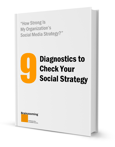Here is a strategy question for you.
When your organization is the size of a country (at least economically), but without the military and police protection to squelch uprisings, what do you do?
Answer?
You deal with uprisings (including negative publicity, boycotts, business loss, and litigation) by trying to reach the people most likely to incite the biggest uprisings and head things off beforehand. You also attempt to target those who could help effectively dampen uprisings that do occur.
Granted, this strategy question is one only Walmart and a few other companies have to address, but the importance of proactively addressing threats to your operational model applies to every organization.
Since the Walmart operational model focuses on low costs and value, the possibility any consumer or marketplace uprising could lead to larger costs, makes it a big deal. Any high profile issue could result in a significant distraction from or direct hit to the core strength and strategic focus at Walmart.
Although this strategic perspective was never overtly stated when Chad Mitchell Senior Director of Digital Communications at Walmart spoke to the September Social Media Club of Kansas City breakfast meeting, I cannot help but believe this thinking is a prime motivator for the Walmart strategy Mitchell shared.
Chad Mitchell on Walmart Social Conversations and Corporate Affairs
Chad Mitchell highlighted the more aggressive use of social media by Walmart to listen and create conversations to influence positive perceptions for the brand’s activities. Chad titled the presentation, "Data-driven Social Media - Leveraging Data to Deliver a Human Social Strategy for a Global Enterprise."
As I tweeted before the talk, if you were expecting cat pictures, you were going to be sorely disappointed.
Chad's social media responsibilities focus on Corporate Affairs, where he has a team of four, including one person on social media and two on the corporate website which receives 20 million visits annually. After his first job at Walmart addressing political and government affairs in Washington, he moved to Bentonville, AR when he took over the social media responsibilities within Corporate Affairs.
Marketing runs the sales side of digital at Walmart where four thousand of the 10,000 Walmart stores have their own Facebook pages. Although the focus between the two areas is different, relationship building is central. As Mitchell puts it, “If you're not on social media to build relationships, it doesn't make much sense to be there.”
Social Media Strategy and Corporate Affairs Objectives
The objective behind the corporate affairs social effort is to have meaningful social conversations to influence perceptions about Walmart. The intent is to be honest and transparent so audience members realize they are interacting with real people at Walmart. Overall, Walmart hopes to use its size and scale to attempt to “influence the world for the better.”
The data-driven enterprise social strategy at Walmart incorporates four elements:
- Human (Cross-functional team, Influence, Data analysis)
- Strategic (Discovery, Risk assessment, Engagement)
- Technology (Monitoring / Research, Content optimization, Analytics)
- Culture (Collaborative planning, Team execution, Command center)
Its keys challenges include overcoming stereotypes, internal perceptions, and audience members’ past experiences with the brand. An additional challenge, according to Mitchell, is that, “Fifty years of being a humble company doesn't set you up for telling your story well.” From a cultural perspective, he pointed to the collaborative culture at Walmart where socializing ideas is expected before initiatives are implemented.
Managing Multiple Content Streams
The primary Walmart Twitter presence is @Walmart, which the Marketing team manages. The main Corporate Affairs Twitter presence is @WalmartHub, with a variety of sub handles (@WalmartGreen, @WalmartHealthy, @WalmartGiving, @WalmartNewsroom, @WalmartAction) for specific content areas.
The audiences Walmart wants to reach for corporate affairs are most available on Twitter. The company has also been aggressive about putting Corporate Affairs content on Facebook too. Initial influencer research identified the top 50 influencers Walmart wanted to reach, and it engages them directly.
According to Mitchell, its approach is on the “Right message, right audience, right time.” While content is focused through the specific sub handles, the best-performing content is subsequently shared through its main Twitter presence as well.
Underlying its social sharing strategy is the idea that, “It's not about when you want to send a message, but when the audience wants to consume it." In light of this, Walmart uses an application to handle and score content while also assessing the company’s real-time audience presence. Since Chad noted seeing 18% swings in its audience size within a very short time frame, it waits to push social content to optimize the audience presence.
Walmart promotes its best-performing tweets to extend their reach and story lifecycles. It also promotes messages to counter negative mentions with the hope of putting an alternative view in place. It also comments on negative stories to expose its own perspective more broadly.
Relative to answering questions, the response gap has been generally narrowed from two or more days to 10-15 minutes, especially on simple, fact-oriented questions.
Toward a Predictive Social Strategy
Walmart, much to Chad’s chagrin, does not yet have an explicit formula for how to adjust the volume of social activity and impact. As a result, it is making message-specific decisions based on available data as conversations play out.
One scale-related challenge for Walmart is being mentioned hundreds of thousands of times online daily. It estimates approximately 80,000 of these are relevant mentions. It generates internal alerts to highlight mentions, activity volume, and sentiment. There is a hope to get to some type of predictive analysis on the impact of social activity based on the various indicators available.
Overall Learnings
In terms of overall learning, Chad Mitchell identified four highlights for other organizations to embrace:
- Build the system right
- Implement a data-driven strategy
- Build the right team
- Pick the right specialty agencies (a preference for Mitchell vs. agencies trying to do everything)
Finally, according to Mitchell, when it comes to enterprise social strategy, “Data should be your friend.” - Mike Brown
Enjoy this article? Subscribe to the free Brainzooming email updates.
“How strong is my organization’s social media strategy?”
Is your social media implementation working as well as it can? In less than 60 minutes with the new FREE Brainzooming ebook “9 Diagnostics to Check Your Social Strategy,” you’ll have a precise answer to this question.
Any executive can make a thorough yet rapid evaluation of nine different dimensions of their social media strategies with these nine diagnostics. Download Your Free Copy of “9 Diagnostics to Check Your Social Strategy.”





